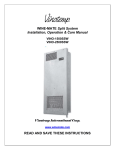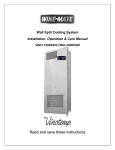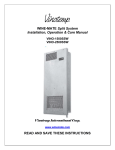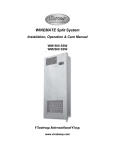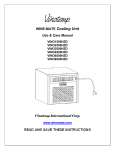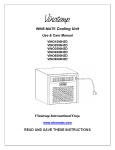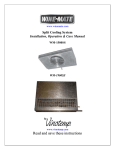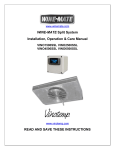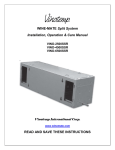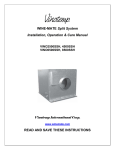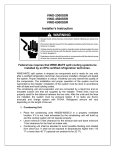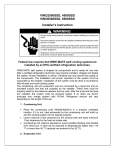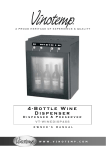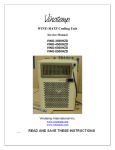Download Vinotemp WINE-MATE 250SCU User's Manual
Transcript
VINO-1500SSW VINO-2500SSW Installer’s Instruction Federal law requires that WINE-MATE split cooling systems be installed by an EPA certified refrigeration technician. WINE-MATE split system is shipped as components and is ready for use only after a certified refrigeration technician has properly installed, charged and tested the system. Proper installation is critical. Vinotemp can only warrant the quality of the components. The installation and proper operation of the system must be warranted by the installer. Installation of the system must be done in accordance with all state and local building codes. The condensing unit and evaporator unit are connected by a liquid line and an insulated suction line that are supplied by the installer. These lines must be properly sized for the distance between the two units. After the units and the lines are installed, the system must be pressure tested. If no leaks are found, evacuate and charge system with R134A. Refrigerant amount will vary depending on the length of line set. 1. Condensing Unit • • • Place the condensing units WM-150SCU and 250SCU in a properly ventilated location. If it is not, heat exhausted by the condensing unit will build up and the cooling system will not operate properly. Leave minimum 5 feet clearance for the exhaust side and leave minimum 1 foot clearance for the fresh air intake side. Condensing unit shall be elevated to avoid possible flooding and shaded from direct sun. It shall not be exposed to temperatures higher than 110 °F or lower than 45 °F (optional low ambient kit for 20 °F). 2. Evaporator Unit • • • The WM-15SFCW and 25SFCW evaporator units shall be installed for wall mount with the air supply on the top and air return on the bottom. Supply and return air flow from the evaporator unit shall be unobstructed for at least 1 foot. There is a gravity drain line so that it can not be installed above the evaporator unit. Otherwise a condensation pump must be used. 3. Air Sensor • The air sensor can be located in the wine room or the return air area, but not the supply air area. 4. Refrigeration Piping and Charging NOTES: ALWAYS USE THE SUPERHEAT AND SUBCOOLING, PRESSURE READINGS TO CHARGE REFRIGERANT PROPERLY, THE LISTED CHARGES ARE FOR REFERENCE ONLY. • • • • • • The installation order starts from condensing unit (including the receiver), liquid line filter-drier, moisture-liquid indicator (sight glass), liquid line, evaporator unit (including liquid line solenoid valve and thermostatic expansion valve or automatic expansion valve), suction line, and returning to condensing unit. The subcooling at the condensing unit shall be around 10°F. The charge may be complete when there are no more bubbles forming in the sight glass. The evaporator’s constant pressure expansion valve is set around 3840°F at factory. This pressure setting gives a dew point to maintain the humidity for storing wine. The superheat at the evaporator unit shall be around 9-18°F under low and high load at 75°F ambient temperature. Low side pressure: around 33 psig High side pressure: 130 -150 psig at 75 -90 °F ambient temperatures The line sizes and refrigerant charges are listed as follows. MODEL VINO1500SSW VINO2500SSW REFRIGERATION LINES < 50 FT < 50 FT LIQUID LINE 1/4" OD 1/4" OD -1- SUCTION LINE DRAIN LINE 3/8” OD 1/2” OD 3/8” OD 1/2” OD CHARGE R134a/ 15 OZ R134a/ 20 OZ 5. Pressure, Superheat and Subcooling Readings NOTES: THE VALVES MUST BE IN THE MIDDLE POSITIONS TO READ PROPERLY. Complaint a. High suction pressure and low head pressure b. High suction pressure and low head pressure Low superheat and low subcooling c. High suction pressure and high head pressure Low superheat and high subcooling d. High to normal suction pressure and high head pressure Low subcooling e. High suction pressure and high head pressure Low subcooling f. High suction pressure and high head pressure High superheat g. Low suction pressure and low head pressure High superheat and low subcooling h. Low suction pressure and low to normal head pressure High superheat and high subcooling i. j. k. l. m. n. o. Low suction pressure and low head pressure Low subcooling Low suction pressure and low head pressure Low superheat and low subcooling Low suction pressure and low to normal head pressure High superheat and normal to high subcooling Low suction pressure and normal head pressure High superheat and normal subcooling Low suction pressure and high head pressure High superheat and high subcooling Low suction pressure and high head pressure High superheat and high subcooling low to normal suction pressure and high head pressure High to normal superheat and high subcooling Possible Causes a. Compressor may be bad b. Expansion valve opened, too much oil c. Overcharge d. Non-condensable gas e. Air restricted, dirty condenser, bad condenser fans f. High room temperature, high evaporator load g. Undercharge h. Liquid line restricted receiver, solenoid restricted i. Suction line restricted j. after valve k. Air restricted at evaporator, evaporator iced Evaporator restricted l. Expansion valve restricted m. Both evaporator and condenser restricted n. Liquid line restricted before receiver o. Condenser restricted 6. Valve Operation SPINDLE BACK POSITION SPINDLE FRONT POSITION Fig. 2.1 Valve Operation -2- SPINDLE MIDDLE POSITION Back Position: Process and manometer port closed for normal operation Front Position: Main connection to liquid or suction line closed Middle Position: All ports open for vacuum, charge and measurement 7. Electrical Wiring Fig. 2.2 VINO1500-2500SSW Wiring Diagram (DIGITAL CONTROLLER) -3- 8. Use of the adjustable low pressure control (if applicable) Cut out = 5 psig; Cut in = 25 psig; Differential = 20 psig It may need to adjust the setting in the field to get the right cycle time. Fig. 2.3 Adjustable Pressure Control 9. Condensing Unit Troubleshooting Unit not running a. Incorrect power supply b. Incorrect or loose wirings c. Failed components d. Liquid refrigerant in the compressor e. Low pressure switch shutting down the system a. Check for proper voltage b. Check all wirings and connections c. Check start relay, start capacitor, overload protector, compressor. d. Call service for OEM information e. Check for system restriction or low refrigerant -4-





